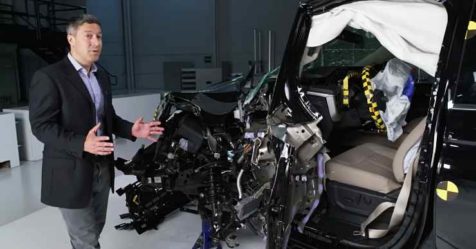Big SUV Doesn’t Mean Safer: Crash Test Shows This [Video]


When it comes to vehicle safety, many car buyers assume that bigger SUVs are better. However, you’d be shocked to know that this is not true. In recent crash tests conducted by the Insurance Institute of Highway Safety (IIHS), it has been revealed that large SUVs may not be as safe as they appear. This is especially true for the second-row occupants, which failed to get adequate protection in these bigger SUVs.
The video showing the crash tests of these bigger SUVs has been shared on YouTube by IIHS. In this video, the organization tested three popular American body-on-frame SUVs: the Chevrolet Tahoe, Ford Expedition, and Jeep Wagoneer. The crash tests revealed that these vehicles passed front and side-impact tests with flying colors.
However, they all fell short in protecting passengers in the second row. According to the IIHS, “Measurements taken from the rear dummy showed a fairly high risk of chest injuries because of high seatbelt forces.” David Harkey, President of IIHS, explained the mixed safety performance of these large SUVs.

He pointed out that while their massive size offers additional protection in crashes with smaller vehicles, they pose a greater danger to other road users. He added that managing the force exerted in crashes involving stationary objects, like trees or barriers, is more challenging due to their large size.
IIHS, while analyzing the specific results, stated that the Jeep Wagoneer, although it earned a 2024 Top Safety Pick award, did not receive the higher Top Safety Pick+ award. It received high marks for front and side-impact protection but was rated marginal in the moderate overlap front test.

The Chevrolet Tahoe also showed substantial risks of lower leg injuries for drivers. In addition, it did not perform well in the passenger-side test. Lastly, the Ford Expedition, despite having second-row belt pretensioners, failed to outperform its rivals in protecting rear-seat occupants. Large SUVs also pollute more.
Now, although in India we do not have ladder-on-frame SUVs as big as these American SUVs, we still have fairly large SUVs such as the Toyota Fortuner, MG Gloster, Mahindra Scorpio-N, and others. So just like driving big SUVs in the USA, there are unique challenges in driving these bigger SUVs in India as well. Here are some essential tips to ensure your safety and that of others on the road.

The first thing you have to do is to familiarize yourself with the size of your SUV. This knowledge is extremely important for navigating tight spaces and avoiding obstacles.
Properly adjusting your seat, mirrors, and steering wheel ensures maximum visibility and control over your vehicle.
Avoid sudden turns and rapid lane changes. This is because bigger SUVs are more prone to rollovers. Ensure gentle acceleration and braking to maintain stability.

Large SUVs require longer stopping distances. Always keep a generous distance from the vehicles ahead to ensure you have ample time to react.
SUV drivers can utilize features like reverse cameras, blind-spot warnings, and parking sensors to avoid hitting other cars or people. These technologies provide extra safety layers, especially in challenging driving conditions.
Adapt your driving to off-road conditions by adjusting speed. If driving on extremely difficult terrains, engage the appropriate settings like four-wheel drive.

The drivers of bigger SUVs should always stay alert and anticipate other drivers’ actions. Drivers should constantly monitor their surroundings to react quickly to any potential hazards.

Now, if you are a driver of a smaller car, you can also take several measures to ensure your safety.
Small car drivers should opt for cars equipped with modern safety technologies. These should include airbags, crumple zones, and decent BNCAP and GNCAP safety ratings.
Always ensure that all passengers consistently use seat belts. Proper seat belt use significantly reduces the risk of serious injury in an accident.

Use correctly installed child seats and keep children in the back seat. Children under 13 should avoid the front seat to minimize injury risk.
Passengers should sit away from the dashboard or steering wheel. Also, they should keep their feet off the dashboard to avoid severe injuries in case of any mishap.
Maintain visibility, keep a safe distance from larger vehicles, and make sure to use turn signals early to alert other drivers of your intentions before making a turn.
Regularly check and maintain your vehicle’s brakes, tires, lights, and suspension to ensure optimal performance and safety.

When driving through high-risk areas, small car drivers should pay attention and be alert. They should be careful at intersections, in heavy traffic, and on high-speed roads where accidents are more likely to take place.
This is not just for small car drivers, but in general, every driver should stay alert. One should be able to recognize the inherent risks due to the structural differences between small cars and larger vehicles.